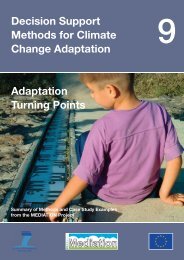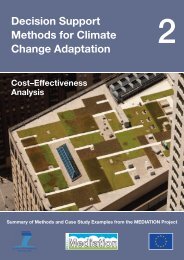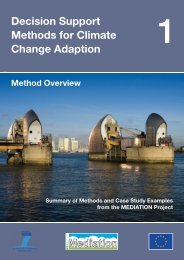Key Messages• There is <strong>in</strong>creas<strong>in</strong>g <strong>in</strong>terest <strong>in</strong> the appraisal ofoptions, as adaptation moves from theory topractice. In response, a number of exist<strong>in</strong>gand new decision support tools are be<strong>in</strong>gconsidered, <strong>in</strong>clud<strong>in</strong>g methods that addressuncerta<strong>in</strong>ty.• The FP7 MEDIATION project has undertaken adetailed review of these tools, and has testedthem <strong>in</strong> a series of case studies. It hasassessed their applicability for adaptation andanalysed how they consider uncerta<strong>in</strong>ty. Thef<strong>in</strong>d<strong>in</strong>gs are <strong>in</strong>clud<strong>in</strong>g on the MEDIATIONAdaptation Platform and summarised <strong>in</strong> a setof policy brief<strong>in</strong>g notes.• One of the tools recommended for adaptationis Portfolio Analysis (PA).• PA is a tool that helps <strong>in</strong> the design andevaluation of portfolios, i.e. <strong>in</strong> select<strong>in</strong>g a setof options which (together) are effective over arange of possible future climates, rather thana s<strong>in</strong>gle option best suited to one possiblefuture.• The approach <strong>all</strong>ows the identification ofefficient portfolios, i.e. those that have thehighest possible expected return for a givenrisk, or the lowest degree of risk for a givenrate of return. This then provides the <strong>in</strong>vestoror decision maker with a choice of alternative(efficient) portfolios, which they can choosefrom based on their risk-return preferences.• The approach has considerable potential foraddress<strong>in</strong>g climate change uncerta<strong>in</strong>ty,through the use of portfolios of options ratherthan s<strong>in</strong>gle solutions. It has a high resonancewith the concepts of iterative riskmanagement <strong>in</strong> its encouragement ofdiversification (a key part of riskmanagement). The approach can be usedwith<strong>in</strong> an economic analytical framework andcan also assess portfolios <strong>in</strong> terms of nonmonetary(physical) effectiveness.• The review has considered the strengths andweakness of the approach for adaptation. Thema<strong>in</strong> strength of portfolio analysis is that itprovides a structured way of address<strong>in</strong>g(climate change) uncerta<strong>in</strong>ty through theidentification of suitable comb<strong>in</strong>ations ofoptions that – between them – reduce climateimpacts over the range of impact uncerta<strong>in</strong>ty,express<strong>in</strong>g the effectiveness of alternativeportfolios <strong>in</strong> quantitative terms.• This provides a way of manag<strong>in</strong>g uncerta<strong>in</strong>tythat the analysis of <strong>in</strong>dividual adaptationoptions does not <strong>all</strong>ow. It can also assessbenefits <strong>in</strong> economic or physical terms,<strong>all</strong>ow<strong>in</strong>g application <strong>in</strong> market and non-marketsectors.• The potential disadvantages are that it isresource <strong>in</strong>tensive, requires a high degree ofexpert knowledge, and relies on theavailability of quantitative data. The approachalso requires the use of probabilities, whichcan prove ch<strong>all</strong>eng<strong>in</strong>g for the application toclimate change. The technique is obviouslynot relevant when one option addresses thefull range of uncerta<strong>in</strong>ty <strong>in</strong> climate impacts.• Previous applications of PA for adaptationhave been reviewed and a number ofadaptation case studies are summarisedwhich provide <strong>in</strong>formation on practicalapplications.• The review and case studies provide useful<strong>in</strong>formation on the types of adaptationproblem types where PA might beappropriate, as well as data needs, resourcerequirements and good practice lessons.• PA is a key tool for help<strong>in</strong>g to identify andanalyse alternative portfolios of adaptationoptions. It has a clear application <strong>in</strong> caseswhere adaptation actions are likely to becomplementary <strong>in</strong> reduc<strong>in</strong>g climate risks.
Portfolio AnalysisIntroductionThere is <strong>in</strong>creas<strong>in</strong>g policy <strong>in</strong>terest <strong>in</strong> the appraisalof options, as adaptation moves from theory topractice. At the same time, it is recognised thatthe appraisal of climate change adaptation<strong>in</strong>volves a number of major ch<strong>all</strong>enges,particularly the consideration of uncerta<strong>in</strong>ty <strong>in</strong>the climate impacts addressed. In response, anumber of exist<strong>in</strong>g and new decision supporttools are be<strong>in</strong>g considered for adaptation.The European Commission FP7 fundedMEDIATION project (Methodology for EffectiveDecision-mak<strong>in</strong>g on Impacts and AdaptaTION) islook<strong>in</strong>g at adaptation decision support tools, <strong>in</strong>l<strong>in</strong>e with its objectives to advance the analysis ofimpacts, vulnerability and adaptation, and topromote knowledge shar<strong>in</strong>g through aMEDIATION Adaptation Platform (http://www.mediation-project.eu/platform/). To complementthe <strong>in</strong>formation on the Platform, a series of <strong>Policy</strong><strong>Brief<strong>in</strong>g</strong> <strong>Notes</strong> have been produced on DecisionSupport Methods for Climate Change Adaptation.An overview of <strong>all</strong> the decision support toolsreviewed is provided <strong>in</strong> <strong>Policy</strong> <strong>Brief<strong>in</strong>g</strong> Note 1:Method Overview, which summarises eachmethod, discusses the potential relevance foradaptation and provides guidance on theirpotential applicability. The methods considered<strong>in</strong>clude exist<strong>in</strong>g appraisal tools (cost-benefitanalysis, cost-effectiveness analysis and multicriteriaanalysis), as well as techniques that morefully address uncerta<strong>in</strong>ty (real options analysis,robust decision mak<strong>in</strong>g, portfolio analysis anditerative risk (adaptive) management). It also<strong>in</strong>cludes complementary tools that can assist <strong>in</strong>adaptation assessment, <strong>in</strong>clud<strong>in</strong>g analyticalhierarchic processes, social network analysisand adaptation turn<strong>in</strong>g po<strong>in</strong>ts. Additional<strong>in</strong>formation on each method is presented <strong>in</strong> aseparate <strong>Policy</strong> <strong>Brief<strong>in</strong>g</strong> <strong>Notes</strong> (2 – 10).This <strong>Policy</strong> Brief (Note 5) provides a summary ofPortfolio Analysis. It provides a brief synthesisof the approach, its strengths and weaknesses,the relevance for adaptation, how it considersuncerta<strong>in</strong>ty, and presents case study examples.It is stressed that this note only provides anoverview: more detailed <strong>in</strong>formation is available<strong>in</strong> MEDIATION deliverables, and sources andl<strong>in</strong>ks on the MEDIATION Adaptation Platform.Description of the MethodPortfolio Analysis (PA) orig<strong>in</strong>ated <strong>in</strong> the f<strong>in</strong>ancialmarkets as a way of utilis<strong>in</strong>g portfolios of assetsto maximise the return on <strong>in</strong>vestments, subjectto a given level of risk. The pr<strong>in</strong>ciple is thatspread<strong>in</strong>g <strong>in</strong>vestments over a range of assettypes also spreads risks.S<strong>in</strong>ce <strong>in</strong>dividual assets are likely to have differentand unpredictable rates of return over time, an<strong>in</strong>vestor may be better <strong>in</strong> maximis<strong>in</strong>g theexpected rate of return and m<strong>in</strong>imis<strong>in</strong>g thevariance and co-variance of their asset portfolioas a whole, rather than manag<strong>in</strong>g assets<strong>in</strong>dividu<strong>all</strong>y (Markowitz, 1952).As long as the co-variance of assets is low, thenthe over<strong>all</strong> portfolio risk is m<strong>in</strong>imised (for a givenrate of over<strong>all</strong> return). Aggregate returns for an<strong>in</strong>dividual <strong>in</strong>vestor are therefore likely to behigher when low returns on an <strong>in</strong>dividual stockare at least partly offset by higher returns fromother stocks dur<strong>in</strong>g the same period.PA helps <strong>in</strong> the design of such portfolios. Ithighlights the trade-off between the returns onan <strong>in</strong>vestment and the risk<strong>in</strong>ess of that<strong>in</strong>vestment, measur<strong>in</strong>g risk by estimat<strong>in</strong>g thevariance (standard deviation) of the portfolioreturn: thus a portfolio with a relatively high (low)variance is judged to have a higher (lower) risk.The <strong>in</strong>formation on returns and risks is used toidentify a portfolio that most closely matches(risk) preferences.The over<strong>all</strong> concepts of the approach are fairlystraightforward, though the actual analysis isquite complex.An <strong>in</strong>vestor first identifies those portfolios thatare efficient (from a longer list of <strong>all</strong> feasibleportfolios). The efficient portfolios have thehighest possible expected return for a given risk,or the lowest possible degree of risk for a givenmean rate of return (Aerts et. al. 2008). The<strong>in</strong>vestor is then able to choose a portfolio thatbest represents their balance of preferencesbetween risks and returns.A representation of this choice is given below,plott<strong>in</strong>g the expected return aga<strong>in</strong>st the variance.In this example, the sm<strong>all</strong> circles represent1





